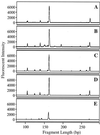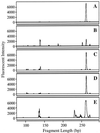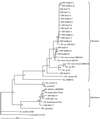Ammonia- and nitrite-oxidizing bacterial communities in a pilot-scale chloraminated drinking water distribution system
- PMID: 11772611
- PMCID: PMC126589
- DOI: 10.1128/AEM.68.1.73-81.2002
Ammonia- and nitrite-oxidizing bacterial communities in a pilot-scale chloraminated drinking water distribution system
Abstract
Nitrification in drinking water distribution systems is a common operational problem for many utilities that use chloramines for secondary disinfection. The diversity of ammonia-oxidizing bacteria (AOB) and nitrite-oxidizing bacteria (NOB) in the distribution systems of a pilot-scale chloraminated drinking water treatment system was characterized using terminal restriction fragment length polymorphism (T-RFLP) analysis and 16S rRNA gene (ribosomal DNA [rDNA]) cloning and sequencing. For ammonia oxidizers, 16S rDNA-targeted T-RFLP indicated the presence of Nitrosomonas in each of the distribution systems, with a considerably smaller peak attributable to Nitrosospira-like AOB. Sequences of AOB amplification products aligned within the Nitrosomonas oligotropha cluster and were closely related to N. oligotropha and Nitrosomonas ureae. The nitrite-oxidizing communities were comprised primarily of Nitrospira, although Nitrobacter was detected in some samples. These results suggest a possible selection of AOB related to N. oligotropha and N. ureae in chloraminated systems and demonstrate the presence of NOB, indicating a biological mechanism for nitrite loss that contributes to a reduction in nitrite-associated chloramine decay.
Figures








References
-
- Brodtmann, N. V., and P. J. Russo. 1979. The use of chloramine for reduction of trihalomethanes and disinfection of drinking water. J. Am. Water Works Assoc. 71:40–42.
-
- Eaton, A. D., L. S. Clesceri, and A. E. Greenberg (ed.). 1995. Standard methods for the examination of water and wastewater, 19th ed. American Public Health Association, Washington, D.C.
Publication types
MeSH terms
Substances
Associated data
- Actions
- Actions
- Actions
- Actions
- Actions
- Actions
- Actions
- Actions
- Actions
- Actions
- Actions
- Actions
- Actions
- Actions
- Actions
- Actions
- Actions
- Actions
- Actions
- Actions
- Actions
- Actions
- Actions
- Actions
- Actions
- Actions
- Actions
- Actions
- Actions
- Actions
- Actions
- Actions
- Actions
- Actions
- Actions
- Actions
- Actions
- Actions
- Actions
- Actions
- Actions
- Actions
- Actions
- Actions
- Actions
- Actions
- Actions
- Actions
- Actions
Grants and funding
LinkOut - more resources
Full Text Sources
Molecular Biology Databases

